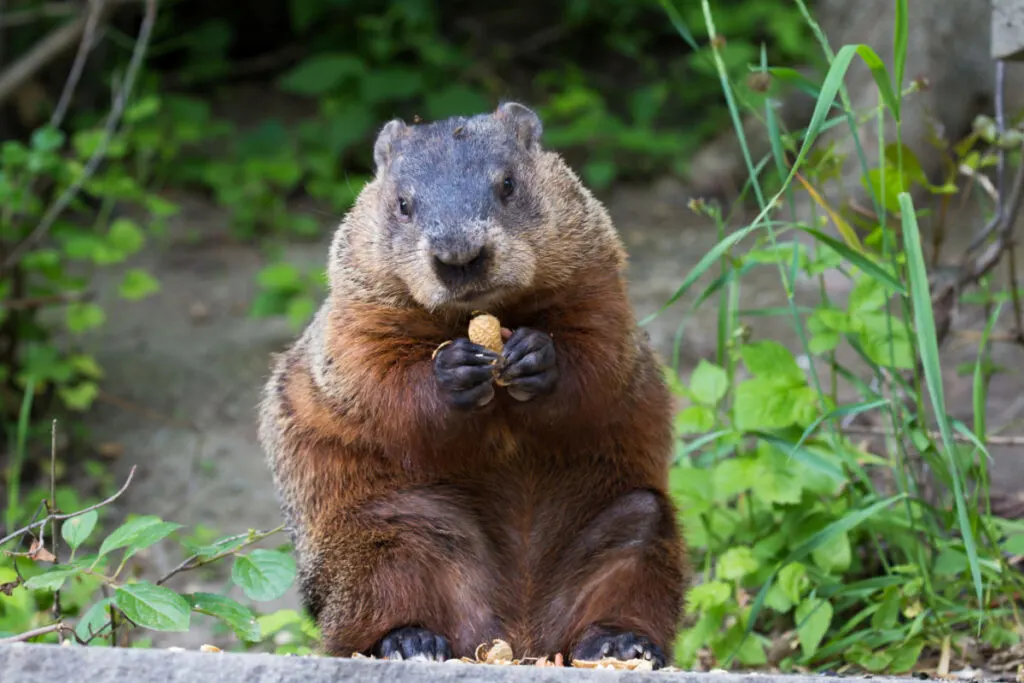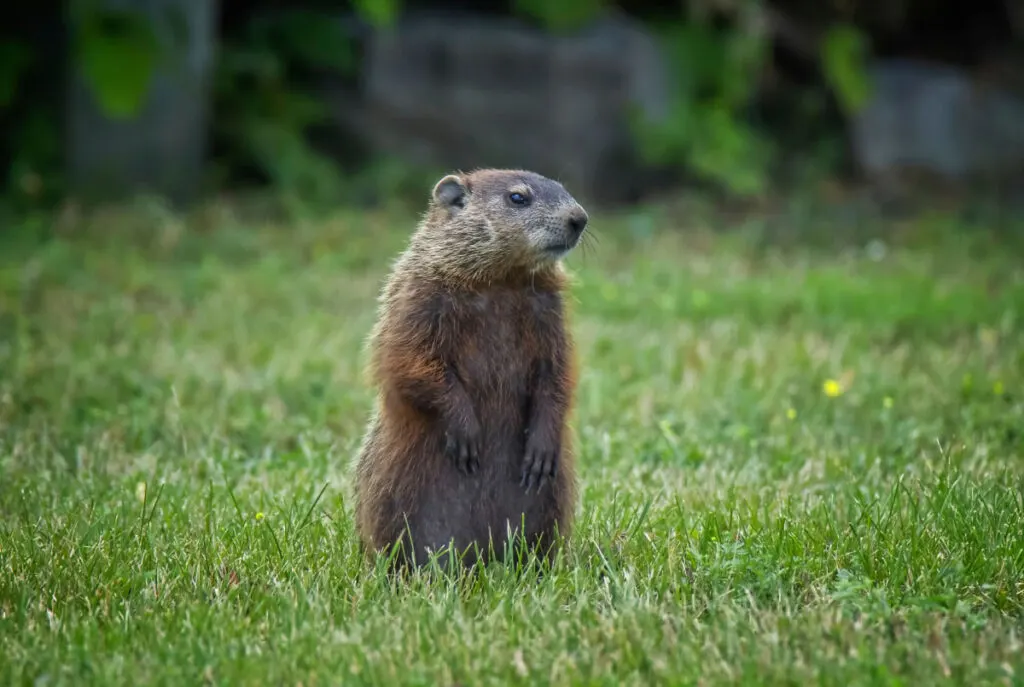Groundhogs or woodchucks are mammalian pests in your garden. These animals destroy your garden crop and you do not want them anywhere near it.
Groundhogs eat a lot of plants. Allowing groundhogs access to your garden can mean the destruction of your plants. Some plants will attract groundhogs to your garden.
Do groundhogs eat pumpkins?
Groundhogs do eat pumpkins. Almost every crop grown in gardens are not safe when there are groundhogs around.
Groundhogs eat every part of your pumpkin plant, so if you are growing pumpkins, it would be in your best interest to prevent them from reaching your pumpkins.

As strictly herbivorous animals, groundhogs eat only plants and plant products. The delicious pumpkin fruits are everything that they could wish for.
Groundhogs can eat every part of a pumpkin including the leaves, stems, fruits, flowers, etc. When your pumpkin plants are producing fruits, you should carefully watch over the plants so that any nearby groundhogs do not eat them.
Table of Contents
Are Groundhogs the Culprit?
If something is eating your pumpkins, you need to know what it is. Here are some ways to tell if it is groundhogs disturbing your pumpkin harvest.
Signs Groundhogs Are Eating Your Pumpkins
Groundhogs are common in bushy areas near open lands. This means that if your farm or garden is not close to a bushy area, there may be no groundhogs around.
- Burrows: Groundhogs dig burrows near building foundations, in open fields, under trees, farms, etc. The opening of these burrows has a large earth mound and is usually 10-12 inches wide. The burrows usually have another opening in a bushy area. If your garden is more than 50-150 feet away from the nearest groundhog burrow, you will not have any groundhog pests as they do not go too far away from their burrows.
- Bitten Fruits: Your fruits can have good-sized bites taken out of them. Carefully observe your pumpkins and other ripened fruits in your garden. If some fruits are bitten, it could be caused by groundhogs.
- Leaves Eaten: Groundhogs are herbivorous, so they eat the leaves of your pumpkins and other plants. If you have carrots in your garden, check their leaves because groundhogs love to eat carrot leaves.
How Groundhogs Damage Your Pumpkins
Here are two major ways that groundhogs can kill your pumpkin plants:
- Eating the Plants: Groundhogs eat every part of pumpkins. They eat the fruit flesh, rinds, seeds, flowers, leaves, etc. No part of your pumpkin will be spared by groundhogs, so you must prevent groundhogs from reaching the plants.
- Destroying the Roots: Groundhogs dig burrows under your plants. This activity can damage the roots of your plants and kill the plants afterward.

How to Prevent Groundhogs from Eating Your Pumpkins
First of all, you should make sure that the method that you choose to use to get rid of the groundhogs is approved by local laws and regulations. Here are some common ways to prevent groundhogs from entering your garden:
- Fencing: You should install a fence around your garden. A metal (wire mesh) fence is recommended. The fence should be at least 3 feet high and 1-2 feet below the ground surface. Fencing is the most common and sustainable way of getting rid of groundhogs.
- Repellents: Repellents are substances such as ammonia, smelly kitty litter, garlic, pepper, etc. that can repel groundhogs. Groundhogs have a sensitive nose and they hate the smell of such repellents. You should spray repellents on plants, garden edges, or even in the groundhog burrows.
- Frighten the Woodchucks: Woodchucks are scared of noise and light, so you can scare them away with those. You should use motion-activated systems to scare the groundhogs with light, water, and noise.
- Block Their Burrows: You should cover the burrows of groundhogs by mixing their mounds with groundhog repellents and covering the hole with the mixture. This will only prevent the groundhogs from raiding your garden for a short time, though, as they will dig another hole soon.
- Use Agricultural Lime: Agricultural lime is hot and discomforts groundhogs. Cover their burrows with agricultural lime to keep them away. Be very careful when using this method as agricultural lime can quickly alter the pH of your soil and kill your acid-loving plants. Only use agricultural lime very far from your garden or whenever you want to alkalize the pH of your garden soil.
There are other ways of getting rid of groundhogs. Note that it isn’t best to use traps as quick-kill traps are prohibited in so many places. Also, groundhogs are vectors of rabies, so using live traps can be risky to you.

Other Fruits and Vegetables That Groundhogs Eat
If you see groundhogs in your garden, you should protect your pumpkins. Asides from pumpkins, however, groundhogs may enter your garden for other plants. Some plants that groundhogs love to eat are:
1. Leafy Greens
Kale, asparagus, broccoli, lettuce, etc. are delicious leafy greens that both you and groundhogs enjoy. If groundhogs have access to a garden with these plants in it, they will leave the garden with their stomachs full and your garden empty.
2. Legumes
Groundhogs love their legumes. Leguminous plants such as beans, peas, peanuts, etc. are some favorite foods of groundhogs as they are rich in proteins and also delicious. Legumes are very easy to destroy by groundhogs, so you want to protect your plants.
3. Cucumbers
Who does not like cucumbers? Groundhogs can eat the leaves, fruits, flowers, stems, etc. of cucumbers. If groundhogs have access to your garden, you can protect your cucumbers by growing them with trellises.
Groundhogs will usually not climb the trellis to eat the fruits, but they can eat the leaves and parts of the stem below.
4. Tomatoes
Groundhogs visit tomato plants because of their fruits. They may not eat the leaves and stems of tomatoes, but they love the fruits. Groundhogs will reduce your tomato harvest if you do not prevent them from reaching your tomatoes.
5. Root Vegetables
Root vegetables such as carrots, potatoes, and yams are not safe from groundhogs either. Hungry groundhogs start with their leaves (asides from potatoes) and may eat the fibrous roots if given the chance.
Truthfully, groundhogs will eat just about any of your garden plants and vegetables that they find.

Related Questions and Answers
1. Do Groundhogs Eat Green (Unripe) Pumpkins?
Groundhogs prefer ripe pumpkins to unripe ones. If your pumpkins are unripe, groundhogs will eat the pumpkin leaves and other parts of the plant.
Note that not every part of the fruit ripens at once, so groundhogs may search for the ripe part and eat it while leaving the unripe parts.
2. Aside from Plants, What Can Attract Groundhogs to Your Garden?
Here are some items that can bring groundhogs into your garden:
- Leftover food: How do you dispose of your food? If the waste bin is open and accessible to pests such as groundhogs, they will visit your garden often.
- Pet Feed: When feeding your pets, make sure that they eat indoors or their leftover is well-disposed of so that groundhogs cannot reach it.
- Compost Pile: Compost piles have a lot of organic materials that groundhogs will surely love. If there are groundhogs in your area, you should consider using a closed compost bin (with tiny holes to air circulation).
Make sure that groundhogs do not have access to anything that can attract them to your garden.
3. What Other Animals Can Eat Your Pumpkins?
Examples of more animals that can eat pumpkins are:
- Rabbits
- Squirrels
- Deer
- Possums
- Hedgehogs
- Snails and other little critters
Final Thoughts
Groundhogs can eat pumpkins and they can destroy the crops by damaging the roots through their digging.
You should use a fence or any of the other methods in this article to help prevent groundhogs from entering your garden and destroying your hard-earned crops.
Sources
- https://pss.uvm.edu/ppp/articles/woodchucks.html
- https://www.thespruce.com/groundhog-damage-in-yard-2131141
- https://dengarden.com/gardening/How-to-Get-Rid-of-Woodchucks-Ground-Hogs
- https://bobbex.com/can-cute-groundhog-really-cause-damage/
